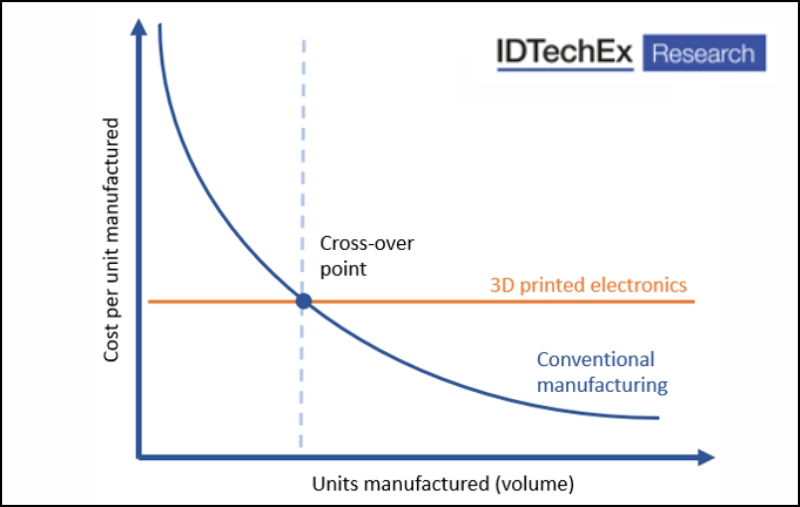
3D electronics market to reach $3bn by 2030 : IDTechEx Forcast
16 September 2020: Dr. Matthew Dyson, Technology Analyst at IDTechEx, has recently published the below article on the topic of 3D printed electronics. This article follows the release of the brand new IDTechEx report, “3D Electronics 2020-2030: Technologies, Forecasts, Players”.
3D Printed Electronics for Agile, On-Demand Manufacturing
Efficient supply chains are one of the wonders of the modern world, with an iPhone requiring components from suppliers in over 40 countries. Production volumes throughout the supply chain usually based on sales predictions. If demand remains as expected, this works well, with little waste. However, if consumer tastes or requirements suddenly change, if sales of a new product are a lot better or worse than expected, or if a particular part is needed unexpectedly in remote location or at very short notice, existing supply chains are a lot less efficient. Unused components pile up, new components cannot be supplied quickly enough to meet demand (potentially delaying an entire production run), costs rise, and ultimately the potential purchaser ends up being disappointed.
On-demand manufacturing offers a solution. Rather than predicting what will be needed in advance and having a supply chain in place to meet those predictions, the idea is to manufacture in response to demand. This should reduce waste, enable companies to adapt to changing requirements in a more agile fashion, and facilitate greater customization. 3D printed electronics, here explored in detail, is an emerging technology that enables this new manufacturing paradigm. A detailed analysis of the entire 3D electronics space, including 3D molded interconnect devices (3D-MID) and in-mold electronics (IME), please see IDTechEx’s new report “3D Electronics 2020-2030: Technologies, Forecasts, Players”.
What is 3D printed electronics ?
3D printing, in which a material is deposited layer by layer to build up a 3D object, is a relatively well-established technology. This material is often a thermoplastic, although 3D printing can also be applied to metals and ceramics. One of the main advantages is that specific products with unique specifications can be made to order, enabling cost-effective production of bespoke parts and facilitating on-demand manufacturing. Another advantage is that manufacturing is additive rather than subtractive, meaning that material waste is far less than other manufacturing technologies such as machining. 3D printing is covered in extensive detail in the recently updated IDTechEx report “3D Printing and Additive Manufacturing 2020-2030: COVID Edition”, which covers the impact of COVID-19 across the whole range of 3D printing applications.
3D printed electronics extends the concept of 3D printing to incorporate electronic circuits within a structural dielectric. The dielectric and conductive traces are deposited in each layer, with (in some cases) SMD components mounted within the 3D structure using (usually) conductive adhesive. Passive components such as antennas and capacitors can also be incorporated with the structure along with curved vias and other geometries not compatible with conventional electronics manufacturing methods. The complexity of the functionality produced by 3D printed electronics is impressive, with Nano Dimension’s equipment capable of creating PCBs with up to 50 layers that can incorporate antennas and capacitors within the solid 3D structure.
There are essentially two manufacturing methodologies for 3D printed electronics: printing followed by curing, and stereolithography (SLA). The former has a higher readiness level with printers commercially available, but without parallelization (i.e. multiple nozzles) it is likely to have lower production speeds since SLA that uses light to selectively convert a liquid photopolymer to a rigid plastic rather than rastering a print head.
There are, however, some technical challenges, such as ensuring that objects comprising materials with very different thermal properties can withstand thermal cycling without breaking a connection. High yields are also critical, as one broken connection means the entire part is redundant since repairs are impossible for fully enclosed circuits.
www.IDTechEx.com/Research






